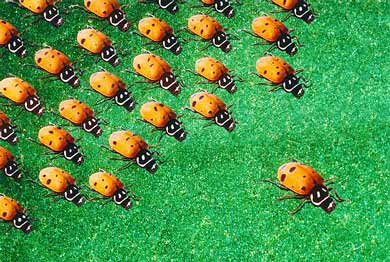





 The lady bug is actually good for your garden.
The lady bug is actually good for your garden.
1. Proper plant selection and good gardening. Select varieties known to be healthy-growing roses for your area. Plan the garden so that roses receive at least six to eight hours of sun a day -- the more sun the better. Plant your roses so that they do not crowd one another, providing optimum air circulation around and through the shrubs. This will lessen stagnant pockets that become an ideal home for disease and insects while also making it easier to keep weeds down. Feed roses with a balanced rose fertilizer on a regular schedule, making sure not to apply too much nitrogen. When overused, this essential fertilizer component causes succulent growth (which is more attractive to insects and more susceptible to disease).
continue reading below2. Observation. Survey the level of trouble in your garden while performing your regular chores. Check for insects and disease as you prune or water. If a particular rose isn't strong and is prone to attack to the point of hardship, remove it. Plant a more vigorous bush in its place.
3. Natural intervention. If a problem arises, turn first to natural and nonchemical intervention. Use water to knock off aphids, or rinse off the underside of rose foliage to remove mites. Clean foliage is healthy foliage. A few products that use biocompatible fungicidal components such as sodium and potassium bicarbonates are proving to be effective in controlling the major foliar disease in the rose family. A good response can be to release predatory insects into your garden to help get pests under control.
4. Low-toxicity intervention. In some circumstances, it may be necessary to resort to slightly more toxic solutions. Products such as horticultural soap that are modified to control insects or diseases are short-term solutions. Horticultural oils, used when the weather permits (temperatures must not be higher than 80 degrees F, or foliage damage will occur), are quite effective against some of the more stubborn pests and diseases.
5. Chemical intervention. For some gardeners, chemical intervention is a perfectly acceptable last resort. But there are wise choices even here. Products such as neem oil or phyrethrins are effective short-term insecticides and can be used with relative safety. They will kill insect allies, however, so don't use them if you have gone to the expense of releasing predatory insects, such as lady bugs. Read the labels, follow the instructions to the letter, and use chemical intervention on a selective basis. Treat the problem, not the garden. If one bush has an infestation of spider mites, then spray only the affected plant.
The choice of sprayers available to rose growers is dependent on the size of the garden. The following is a guide to help you select an appropriate and durable sprayer with the proper capacity for your garden.
1. Small garden (up to 10 plants): The best choice here is a quart sprayer. Such devices provide a handy 1-quart compression sprayer with a high-pressure plastic tank. Units usually have a unique on/off or continuous-on trigger design. The nozzle adjusts spray from a fine mist to a 30-foot jet stream for those hard-to-reach climbers and ramblers.
2. Medium garden (10 to 30 plants): The choice here is at least a 1-gallon sprayer. It only takes a single pump to spray the entire gallon. Units are made of tough, high-impact injection-molded plastic, with a pressure-control gauge for low pressure and no-drift spraying. Comes with 20-inch wand.
3. Large Garden (30 to 100 plants): With this larger garden it is wise to invest in a backpack-sprayer unit with a capacity of 4 gallons (it delivers 75 pounds working pressure per square inch).
4. Very large garden (100 to 500 plants): For mobility, the best choice is a cordless electric sprayer that uses a 12-volt rechargeable battery with a 6-gallon plastic tank and 10 to 20 feet of hose (it delivers 60 pounds working pressure per square inch). Recharging time is approximately eight hours.
Download our helpful chart on disease-resistant flowers. (Downloading requires Adobe Acrobat software.)
Disease-Resistant Roses A-L
Disease-Resistant Roses M-Z
Download Adobe Acrobat
Copyright © www.100flowers.win Botanic Garden All Rights Reserved